|
July
28
We
heard the hyenas several more times through the night, but further
off. A leopard coughed nearby a couple of times, and we could hear
the hooting of a scops owl and the harsh bark of the baboons. It
was a moving day, and we were kind of sorry to leave this
excellent camp. Due to scheduling constraints we could only stay
here two nights, so Gee had arranged for us to spend the last two
days in a more remote area of Moremi.
But first, we were scheduled for a boat trip at 7:00. We headed out
early, and Birthday Bear sat on the console with Fred and Duma. We
could see the dim shapes of storks and ibis in the half-light. An
elephant with just one tusk stood in a pool drinking; then he
showered himself with water sprayed from his trunk.
We
noticed the impala were on the alert and heard the urgent alarm
call of a hornbill; Gee was looking all around for the source of
their fear. Then the leopard appeared, a huge male, standing in
the road in front of us. He stared at us for a few moments before
turning and walking down the track ahead of us. He was all grace
and power. To me he seemed somehow mystical, like a dream creature
that moved through the shadows of my imagination.
The
leopard’s belly was distended; he must have eaten recently. He also looked like he had known some hard times
- he had a nasty cut on his nose and his ears were tattered along
the edges. He
turned off into the underbrush, sniffing the grass as if looking
for something. Gee seemed to know what would happen next; “He is
going to call,” he said, and on cue the leopard let out a series
of deep guttural vocalizations. Then he marked his territory,
raking the dirt fiercely with his hind feet, and continued moving
back and forth sniffing the ground. Gee said he was searching for
a female in estrus. Surely this was the leopard we had heard in
the night.
We
left him to his search and headed toward the river. A large flock
of helmeted Guineafowl swarmed through the underbrush and into the
road in front of us, at least a hundred of them. The size of a
chicken, they have round bodies and delicate black and white
dotted feathers that blended to a blue-grey color in the dim
light. Squawking and flapping, they ran frantically down the road
in front of us as if the sky was falling.
|
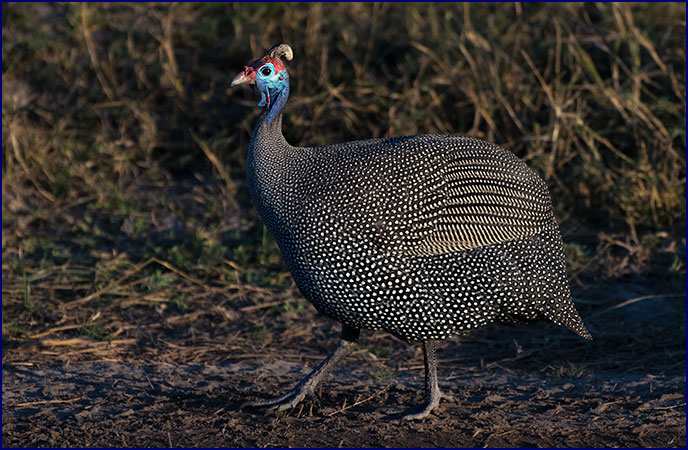
Guineafowl
|
We
passed another safari vehicle; a young girl of about ten clutched
a small stuffed hyena. Fred, Duma and Birthday Bear were all very
interested. We arrived at the boat launch about 35 minutes late,
but nobody seemed to mind.
We
boarded a motor boat big enough that we could all sit comfortably,
and set off down the Khwai River. Our guide for the river trip was
named Bala. Gee stayed behind to guard our belongings and
hopefully catch a nap; we worried that the extra-long game drives
he was taking us on each day must be wearing him out.
The
shore was lined with tall miscanthus and golden pampas grass. We
passed a very fancy 5-star lodge on the left, and then turned out
into the channels through the reeds and pampas grass. We followed
a narrow channel until it opened up into the wide river; it
reminded me of The African
Queen. It was quite beautiful; the dark blue water contrasted
with the golden grass under a deep blue sky. We found the voyage
to be very relaxing.
A
lone hippo poked his head up and watched us suspiciously. Bala
told us to keep alert; there was the possibility of seeing a
situnga, a very rare and shy antelope that lives in the reeds.
Bala
pointed out a coppery-tailed coucal and a squacco heron. He showed
us a tiny island covered with daddy-long-legs nests; the babies
can run across the surface of the water and get to land. Jacanas
skittered over the lilypads and a reed cormorant took flight as we
approached.
|
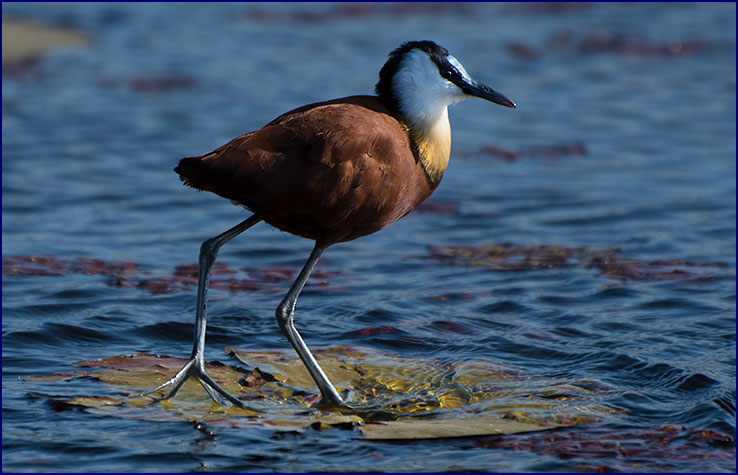
Jacana
|
We
came out into the Xakanaxa Lagoon, where the river widened to an
impressive expanse of water. Bala said there is good fishing
there, for tiger fish and tilapia. Water chestnuts were growing in
the river, the type commonly used in Chinese food. We learned that
the Okavango Delta is over 15,000 square kilometers, and Moremi
National Park covers about a third of that. It was quite cold on
the boat; I shouldn’t have left my coat in the Landcruiser.
|
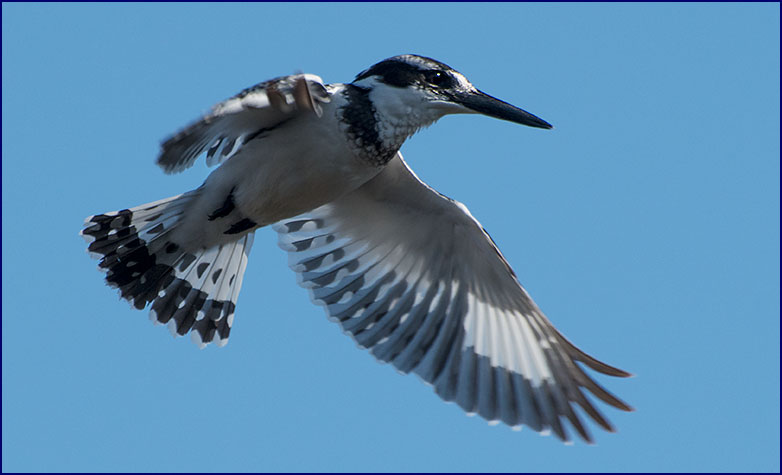
Pied kingfisher
|
A
pied kingfisher hovered above the river; this was the closest we
had been to one of these fascinating birds. It would hover in
place like a helicopter, wings moving so fast they were a blur,
and then suddenly dive down into the water for a fish. We passed a
group of pygmy geese bobbing along with the current; they are the
size of small ducks, and the males have white faces. I am not sure
what makes them a goose rather than a duck – obviously the
difference must be more than just size. An African darter stood on
a small island, bill high in the air and wings outstretched to
dry. We were used to seeing them with just their head and neck
sticking up out of the water; when you can see the whole bird they
are actually very handsome.
|
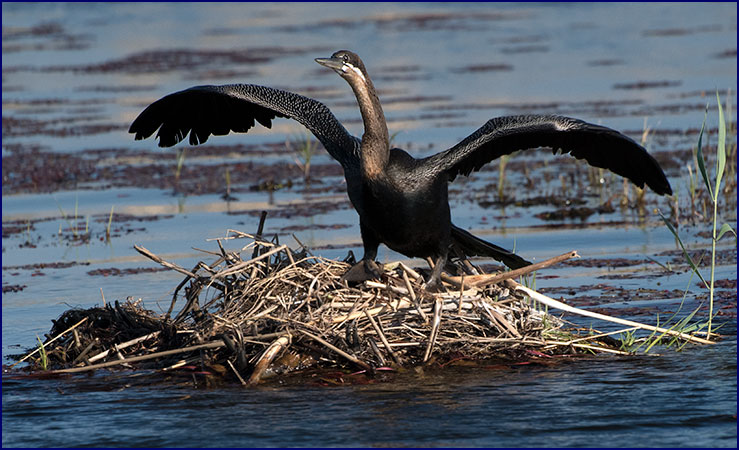
African darter
|
A
number of termite mounds stuck up out of the elephant grass,
always leaning to the west. Bala said many islands were formed
from termite hills: termites
build the hill during the dry season, the birds perch on them,
bringing seeds, then trees grow and silt settles. Before long
islands begin to form.
Entering
a narrow channel, we caught a flash of dark movement in the water
off to our left. It was an otter! We got a brief glimpse (and a
very blurry photo) of the spotted-necked otter as it dived and
then resurfaced, before disappearing into the reeds. We hadn’t
even dreamed of seeing one!
|
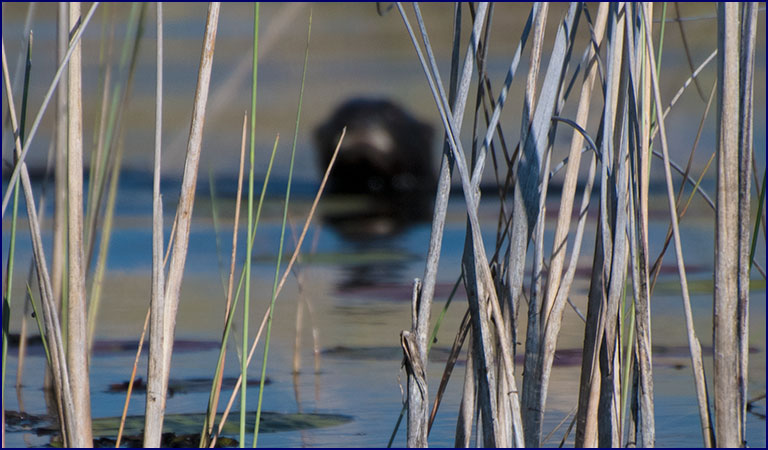
A brief glimpse of a spotted-necked otter
- he disappeared before I could focus!
|
Bala
beached the boat on a broad island, and we got out and walked
around. A heard of lechwe grazed peacefully over on the far side.
There was a small soda flat, and we could see the spoor of the
animals that were attracted to the salty soil. It felt good to get
out and stretch our legs a bit. Tara in particular made a bid for
escape; she was all the way across the island standing on a
termite mound with her arms outstretched when Bala urgently called
her back.
|
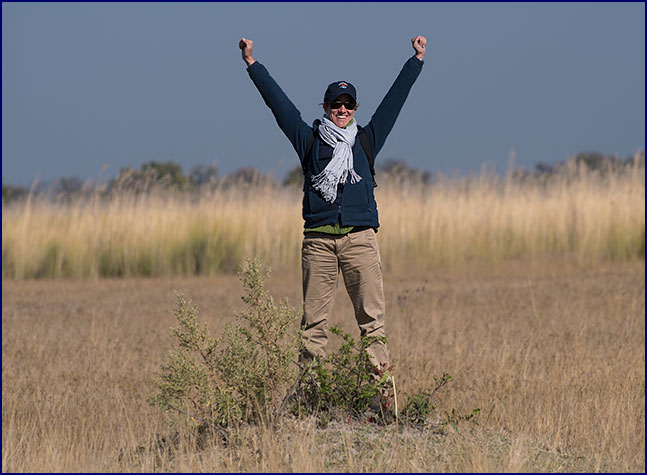
Tara runs wild
|
We
got back in the boat and continued on, admiring the fluffy heads
of papyrus grass. Bala told us that people used to make rafts from
bundles of papyrus to cross the river. We noticed areas of the
lagoon where a lot of floating weeds were growing on the surface
of the water, in places totally covering the surface. Bala said it
was Salvinia Molesta; he said someone bought a second hand boat from
outside the Delta, and when he brought it home it had carried
seeds of this invasive species which spread rapidly through the
Okavango Delta. Salvinia
Molesta sounds like the name of an evil spell from Harry
Potter, and actually that isn’t too far off.
Salavinia
Molesta is
a free-floating duckweed-type plant that spreads quickly, covering
large sections of many of the lagoons. It has infected vast areas
of Moremi. The government started paying farmers to eradicate in
on their farms, but that backfired, as some people actually
planted it so they could be paid to get rid of it. Now they are
bringing in a type of beetle from Australia to control it. Oh,
right, like that ever works, bringing in one invasive species to
control another . . . what could possibly go wrong?
|

Monitor lizard |
Bala
steered the boat close to the shore. A huge monitor lizard rested
in the grass. The monitor lizard is an enemy of the crocodile, as
they eat the croc’s eggs. We also had a good look at a lechwe
and a purple heron that were right on the bank. A colorful little
stone chat perched on the pampas grass.
A
hippo lifted his head up from the water in front of the boat and
stared at us as if trying to decide whether capsizing us was worth
the trouble; apparently not, as he silently disappeared back down
into the depths.
Gee
was waiting for us when we returned to land, and we
enthusiastically told him about what we had seen. For me the otter
and the monitor lizard were the highlights. Sadly though, no
situnga.
We
left the boat area and went back into the forest. Three elephants
were hanging out under a black ebony tree with a trio of warthogs.
Nearby was a troop of baboons, and we watched them with interest.
The large male kept watch like a sentinel while the others spread
out looking for food. We could see him sitting on a fallen tree,
silhouetted in shadow as an elephant passed through the sunlit
meadow behind him.
One
baboon mother walked along with her baby riding high on her rump
like a little cowboy, and another female sat eating a sausage
fruit while her youngster nursed. Several other baboons sat
quietly grooming each other. Some of the older youngsters started
to play, long-legged and athletic, running up and down the fallen
tree. The smaller babies were riding on their moms, either sitting
on her back or clinging upside down under her stomach. The baboons
were fascinating to watch, though somewhat disconcertingly
human-like.
One
of the elephants moved closer, casually snacking on the tall
grass. A greater blue-eared starling shone vivid blue in the
sunlight, and a crested barbet perched in a tree. Two vultures sat
in a dead tree, the more handsome white-backed on a higher branch
and a lappet-faced further down. Several Hartlaub’s babblers
flitted among the branches, with edged feathers and red eyes.
We
made our way across the park, enjoying the scenery.
We
crossed the same pole bridge again, which we learned was called
Fourth Bridge; we paused in the middle of it for a view down the
river. A pied kingfisher hovered and dove, and a black-winged stilt waded
in shallow water.
A fish eagle
surveyed his territory from a tree.
Giraffes
strolled across the marshy plains and red lechwes grazed along the
water. We tried to get some shots of a lilac-breasted roller in
flight, but with limited results. A grey go-away-bird perched on a
thornbush, a handsome grey bird with a perky top-knot. Go
away he implored us with his raspy signature call.
We
crossed another rickety bridge, this one with a ford at the end of
it; this was Third Bridge. A sign said Slow
Down on top of Bridge. We paused to photograph the heads of
papyrus and pampas grass. The crescent moon shone in the afternoon
sky, but now it was upside down like a frown.
|
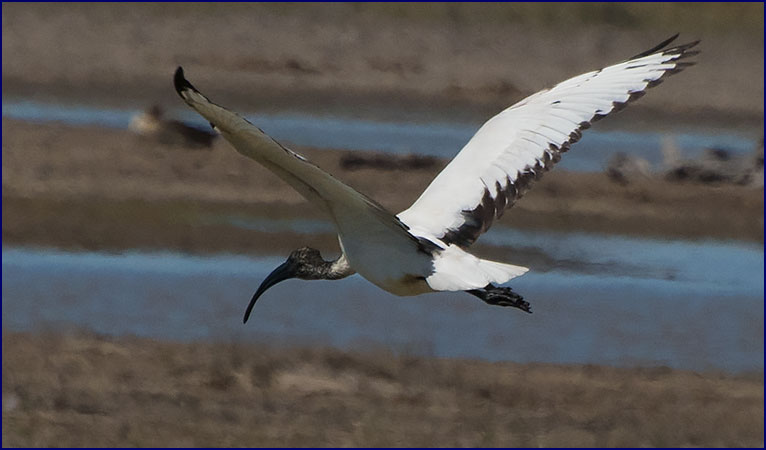
Sacred ibis
|
The
area was a waterfowl’s paradise, full of marshes and wide
lagoons. There were birds everywhere, along with a fair number of
animals. We drove from pool to pool, amazed at the variety.
Several sacred ibis flew in for a landing, and pelicans soared
overhead in formation. Among my favorites were the spoonbills,
wading along with their round shovel-like bills. The yellow-billed
storks were handsome, with a slightly pink tinge in the sunshine.
On the other hand the marabou storks, or undertaker birds, are
startlingly ugly; with their hunched shoulders and bulbous throat
pouch, they are the last stork you would want delivering your
baby.
We
sat at a pond and inventoried the birds and animals we could see
from one spot. Egyptian geese, African spoonbills, a grey heron,
black-winged stilts, Namaqua doves, blacksmith plover, red billed
teal and white faced ducks with babies – along with giraffes,
crocodiles, wildebeests, warthogs, impala and zebras; we could see
all of these without moving! Astounding.
At
another lagoon, several large crocodiles lay along the shore,
mouths held open for cooling. It was surprising how close the
birds would stand to the open mouths and jagged teeth of the
crocs. A darter, swimming with just his head and neck out of the
water speared a good-sized fish with his long pointed beak. A grey
heron started following him; Gee said the heron would try to sca-VENGE
the
fish and take it away from the darter. No chance though, the
darter flipped the fish into the air and gulped it down whole.
|
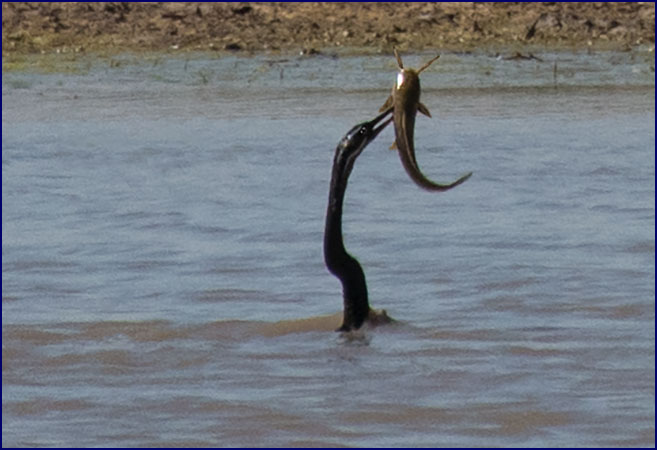
African darter with
lunch
|
We came to a sign for Second Bridge; arrows showed one could get
there by way of the Wet Road or the Dry Road - Gee took the Wet.
We crossed the bridge and continued on past ponds and lagoons
filled with a variety of birds, along with occasional hippos.
There were plenty of crocs around; we saw several little baby
ones, greenish-brown and innocent looking. We watched a great
egret catch a frog.
We
crossed a drier section of plain. A small herd of wildebeest were
running to and fro in the distance. After a few minutes they
settled down, and then they came marching toward us side by side,
about eight of them abreast. They paused as a pair of black-backed
jackals trotted past in front of them, and then went on again,
breaking into a run as they passed us.
A
pair of ostriches paraded along near the road. The female was a
modest brownish grey, and the male quite splendid with his black
and white plumage. The skin on the fronts of his legs was a bright
reddish pink color; Gee says that is how they attract a mate when
courting.
Mid-afternoon
we came to First Bridge, another rickety pole affair. A sign
reminded us, Do Not Speed Over Bridge. Like
the other three before it, this bridge rattled and creaked as we
went across, the logs shifting under the weight of the
Landcruiser. Speeding was the last thing on our minds.
We
crossed a long plain, briefly sharing the road with a bull
elephant in musth. A zebra and a saddle-billed stork stood side by
side. There were a few tall palm trees scattered among the stunted
mopanes - they seemed oddly out of place on the African bushveld.
Though there were many short palm bushes, only a few of them
survived the elephants to grow into tall trees. Gee told us the
area is called Bodumatau, which means A place
where the Lions Roar.
Stopping
the vehicle by a small palm tree, Gee got out and cut a large
frond from it. He then gave us a demonstration on how to weave a
basket. Deftly braiding the long thin leaves as he spoke, he
explained how his people would make a palm basket to carry fruit
or fish in when going to see friends – and in no time at all he
had whipped out a nice example. Jineen was eager to try her hand
at basket-making. When Gee was finished he put the basket on his
head like a hat; it looked quite ridiculous. We all modeled it; I
must say Rob looked the best in it, though it did vaguely make him
look like a gestapo agent. In
the end we put it on the console for Duma, Fred and Birthday Bear
to sit in; they liked it because it felt cozy and safe, and they
had been feeling that Botswana was disconcertingly wide and vast.
|
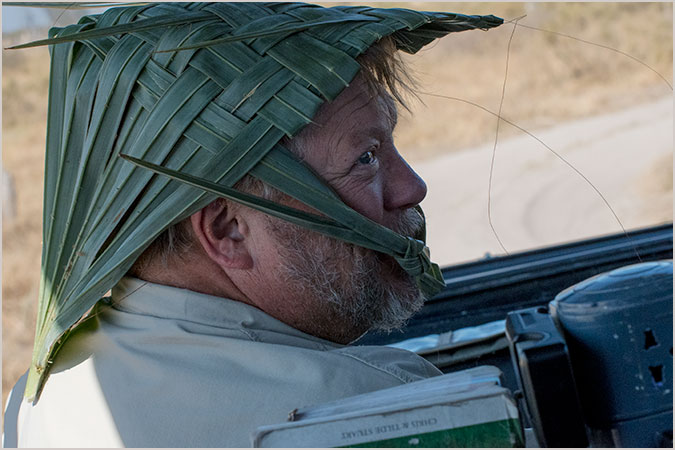
Gestapo
Rob |
A
lilac-breasted roller sat on the top of a tree; Gee stopped for us
to watch. Soon the female stuck her head out of a nest hole, and
they both began singing, their throats stretched wide as they
courted. “He’s going to roll,” Gee told us, and sure enough,
the male roller flew straight up in the air and then plummeted
toward the ground in a series of uncontrolled diving rolls. At the
last possible moment before certain catastrophe he pulled out and
soared upwards again. The female followed suit, taking her turn at
rolling, and they repeated the performance several times. I had
vaguely wondered why these birds were called rollers - now I knew.
|
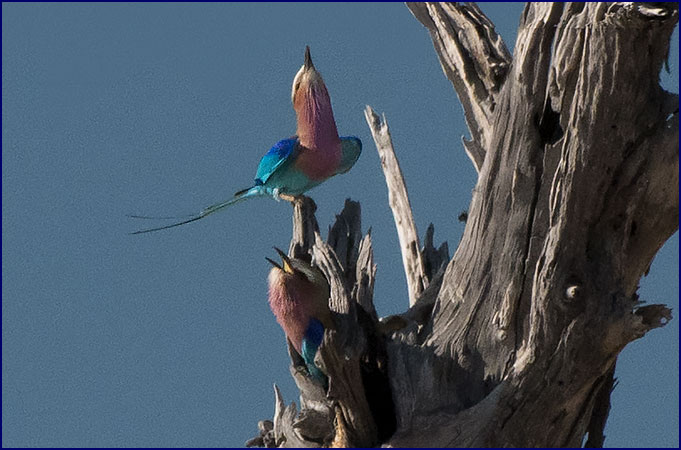
Lilac-breasted
rollers courting |
Throwing
a stick, Gee knocked some palm nuts out of a tree. He handed us
the nuts; they were smooth and brown, and smelled like gingerbread
- Gee said they taste like it too. He pointed out a python creeper
growing on a tree, and said the vines are used when people get
married; it means they will be tied up together forever. A
Bennet’s woodpecker worked his way up a tree trunk. We passed
some self-drivers stuck in the sand, but another guide was helping
them so we drove on.
We
crossed a wide open space; it was an area of elephant devastation,
barren, with many broken trees - there is much the elephants could
learn about the conservation of resources. Hottentot teals paddled
in a small pool. A crocodile was basking in a drying pool; Gee
said the crocs will travel up to 10 kilometers on land if they
need to, travelling only at night, to get to water. Other animals
do not expect to encounter the crocs on land so they are not wary,
and they sometimes get eaten. On the other hand, hyenas and lions
might kill and eat crocs that they catch on land.
Gee
pointed out a greater honey guide; it is said that these birds
will lead people to honey by pointing at the hive with their
tails. They will also lead the honey badgers to the hive. Legend
has it that when the honey guide leads you to a hive, when you
open it and take the honey you must always leave some for the
bird; if you don’t, the next time he will lead you to lions.
Around
4:45 we came to a large waterhole that was absolutely packed with
birds. It was unbelievable. There were big flocks of pink-backed
and great-white pelicans, along with yellow-billed and Marabou
storks. With them were spoonbills, saddle billed storks, sacred
ibis, egrets, black-winged stilts and a few grey herons. It was
practically wall to wall birds; they stood 3 and 4 deep around the
shore - there must have been three hundred or more.
|
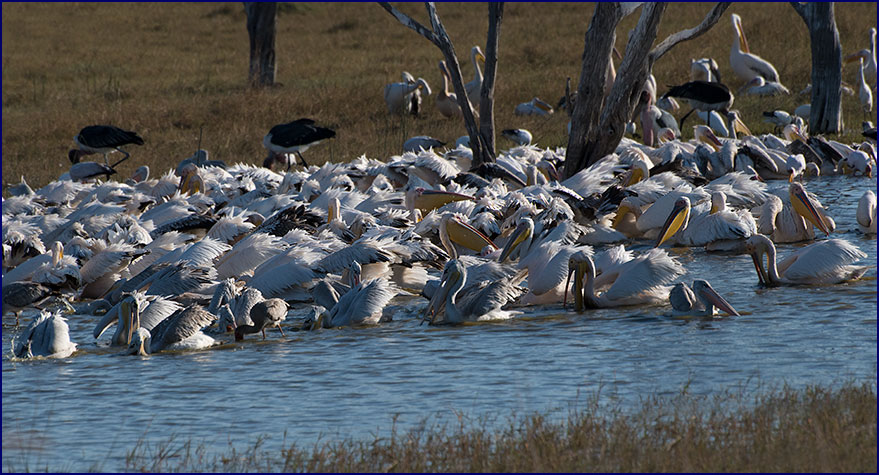
Pelican
Pond |
The
water was seething with fish, and the large birds were moving in
rows, pushing them up into the shallow water near to the shore
before scooping them up and eating them. It was an absolute
feeding frenzy. We dubbed the place Pelican Pond, and spent nearly
an hour watching the incredible show the birds were putting on.
After
a long while the fishing action settled down; the birds must have
eaten all the fish. Then the pelicans started taking turns flying
across to the other side of the pond. One or two at a time, they
would rise ponderously in the air and flap across the pond, to
land on the far shore. The pink-backed pelicans took off clean
from the water, but the whites put their feet down and pushed off,
patting the surface anywhere from 3 to 7 times before getting
airborne, like giant skipping stones. It was extraordinary to
watch.
Moving
on, we came to a big lagoon. We drove alongside it atop a causeway
that had been built to control floodwaters by the people who lived
here before it was a park. Hippo heads poked up out of the water
to stare at us as we went by. Several fat crocodiles lazed on the
banks, and an African marsh harrier flew up in front of us. We
paused to watch as several hippos entered the water, oxpeckers on
board, joining the group out in the middle. Then one big female
hippo came up out of the water; she moved right toward us, backlit
by the lowering sun and framed with sunlit grasses. She turned and
paused, posing a moment while we admired her, and then went off on
some mission of her own.
We
stopped to watch a herd of zebras, including the smallest baby we
had seen on the whole trip. This dainty little equid seemed
curious about us, climbing on a termite mound for a better look. A
lone wildebeest hung out with the herd. One zebra had a scar
across his hindquarters from what must have been a horrific
injury; it was now totally healed up, but his stripes were
misaligned by a good inch.
A
tsessebe bull stood with a small herd of lechwe, standing like a
sentinel, his greyish brown coat appearing slightly purple in the
evening light. Being built so uphill, with front legs longer than
hind, he was in direct contrast with the downhill lechwes whose
stature is completely the opposite.
We
drove back past Pelican Pond to watch the sunset. The pastel
colors were reflected in the water, and pelicans and storks flew
as dark silhouettes against the fiery sky.
We
arrived at our new camp just as it was getting dark. It was a
lovely spot, very private; Gee told us that there is hardly
anybody in this part of Moremi. The camp was right beside a huge
lagoon, and our tent was just a few feet from the water. We
reflected that each camp we’d stayed at had been quite
different, and each has been secluded and beautiful.
|
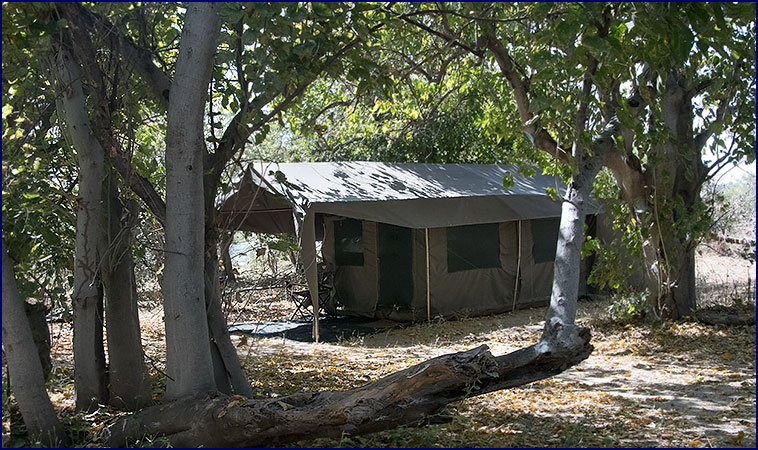
My
tent at our second Moremi campsite |
We
sat around the campfire and talked about the awesome day. We could
hear the hippos in the lagoon splashing and honking. Tomorrow was
to be our last full day on the mobile safari - after all of the
fantastic sightings we had been having, we mused that our last day
would probably be an anticlimactic dud.
Our
group all agreed that Gee was the most amazing guide ever; most of
the guides in Africa are very good, but Gee is exceptional. Having
grown up in the Delta, he has a first-hand knowledge and
understanding of the land and the wildlife that few others have.
We wanted to give him a special gift to remember us by. Gee had
told us earlier in the trip that he’d had to sell his camera to
buy building materials for his house. Having bought a new camera
recently, I had also brought my Nikon D7000 along as a backup; we
gave that to Gee, along with a telephoto lens, as a thank-you
gift. We presented it to him around the fire that evening, and he
seemed to really like it.
We heard the moaning roars of lions in the night; one of my
favorite sounds ever. These sounded like they were not far away
– maybe just across the water. Later we heard the high-pitched
yipping cry of jackals.
|